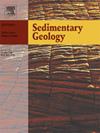Impact of secondary geomorphic processes on sedimentary characteristics of alluvial fans: Implications for reservoir exploration and development
IF 2.9
2区 地球科学
Q1 GEOLOGY
引用次数: 0
Abstract
Alluvial fans, typically characterized by a mixture of fine- and coarse-grained materials, high heterogeneity, and weakly structured organization, are formed through various depositional processes. Fan deposits are considered valuable reservoir exploration targets in the hydrocarbon field worldwide. A series of Quaternary fans in northwestern and northern China, subjected to secondary geomorphological processes of varying degrees, were analyzed. Primary geomorphic processes, characterized by lobe or sheet elements of debris flow, hyperconcentrated flow and sheet floods deposits, generally represent rapid fan aggradation and dominate the sedimentary succession of these fans. Deposition of secondary processes is mainly developed by streamflows reworking with identifiable features, such as sheet-like lag, braided/point bar, and channel elements. A lack of sediment input to the fan and the redistribution and remodification of the primary deposits characterize this process. Synsedimentary reservoir quality is significantly improved by reorganizing sorting, support styles, and bedding structures. The proportion of primary and secondary architectural elements is proposed to evaluate the relative intensity of secondary processes experienced by alluvial fans. The dominant drivers of strong secondary processes are attributed to frequent streamflow events in response to climate changes on millennial timescales. Physical properties and connectivity of alluvial fan reservoirs related to secondary processes are commonly improved compared to reservoirs directly originating from primary processes, as a deep-time example from the Karamay oilfield. The results of this study provide new insights into constructing alluvial fan models in deep-time terrestrial basins and contribute to predicting favorable reservoir distribution and adjusting development strategies for alluvial fan reservoirs worldwide.

次生地貌作用对冲积扇沉积特征的影响:对储层勘探与开发的启示
冲积扇是通过多种沉积过程形成的,具有细粒和粗粒混合、非均质性高、组织结构弱的特点。扇沉积被认为是世界范围内油气领域有价值的储层勘探目标。对西北和华北地区一系列第四纪扇进行了不同程度的次生地貌作用分析。原生地貌过程以碎屑流、高浓度流和片状洪水沉积的叶状或片状元素为特征,通常代表着快速的扇状沉积,并主导着这些扇的沉积演替。次级过程的沉积主要是由河流再加工形成的,具有可识别的特征,如片状滞后、辫状/点坝和河道元素。扇扇缺乏沉积物输入,原生沉积物的重新分配和改造是这一过程的特征。通过重组分选、支撑样式和层理构造,显著提高了同沉积储层质量。提出了主要和次要建筑要素的比例来评价冲积扇所经历的次要过程的相对强度。强次生过程的主要驱动因素是响应千年尺度气候变化的频繁径流事件。以克拉玛依油田为例,与次生作用相关的冲积扇储层的物性和连通性普遍优于直接由次生作用形成的储层。研究结果为建立陆相深生盆地冲积扇模型提供了新的思路,有助于预测全球冲积扇储层的有利分布,调整冲积扇储层开发策略。
本文章由计算机程序翻译,如有差异,请以英文原文为准。
求助全文
约1分钟内获得全文
求助全文
来源期刊

Sedimentary Geology
地学-地质学
CiteScore
5.10
自引率
7.10%
发文量
133
审稿时长
32 days
期刊介绍:
Sedimentary Geology is a journal that rapidly publishes high quality, original research and review papers that cover all aspects of sediments and sedimentary rocks at all spatial and temporal scales. Submitted papers must make a significant contribution to the field of study and must place the research in a broad context, so that it is of interest to the diverse, international readership of the journal. Papers that are largely descriptive in nature, of limited scope or local geographical significance, or based on limited data will not be considered for publication.
 求助内容:
求助内容: 应助结果提醒方式:
应助结果提醒方式:


